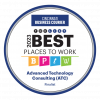
These 10 hotel technology trends, brought to you by ATC provider Mitel, will change everything about how hotels communicate. The “guests” of tomorrow will be more connected than ever before.
***
Once long ago, hotels, motels and other hospitality businesses occupied a fairly simple space in people’s lives—they were a place for guests to lay their heads away from home. But anyone who’s spent time in the hospitality industry in the last several years knows that the role of technology in hospitality businesses has drastically expanded.
In many cases, they’re becoming hubs of activity unto themselves. Most of this activity relies directly or indirectly on technology, making IT more important to hotel operations and the guest experience than ever before.
So we’re here to share ten of the top communication technology trends in hospitality today. Check them out. Think about which ones make sense for your business. And if you see an opportunity, you can get out in front and begin planning accordingly. After all, in hospitality, every advantage counts.
1. Mobile device as door key
It’s fascinating that a function as simple as a door key could undergo so much evolution. But the tool that once started as a carefully shaped piece of metal quickly turned into electronic key cards, and is set to shed its physical form altogether. The next evolution of the hotel key transforms it into data on a guest’s mobile device. Some hotels have already started implementing this, whether it involves NFC technology or visually scanning a code like many airports do now with plane tickets.
2. Service automation
Self-serve is in. Today, many guests prefer technology over human interaction for simple tasks. Remote check-in and check-out options are becoming popular, and some hotels are beginning to work with apps that let guests order room service right from their mobile devices. There’s a whole range of basic guest requests that can be automated with the right technology, which frees hotel staff up for other activities that enhance the guest experience. And, the trend is only going to accelerate.
3. Fixed-mobile convergence
Once upon a time, people used their room phones. However, the pervasiveness of mobile devices has relegated the conventional room phone to a vastly reduced role. But that doesn’t mean it doesn’t have a role moving forward. The room phone of the future may serve as a hub for a larger connected experience.
Imagine a guest arrives at your hotel and pairs his mobile device to his room phone. Now he can use his mobile to control the TV and the sound system, perhaps even the blinds. He can use it to request a wake up call if he finds himself out late. You can let him know that his dry cleaning is ready, even if he’s across town at a meeting. And, if he needs to take his call from your lobby into a cab so he doesn’t miss a meeting—the handoff from Wi-Fi to 4G is seamless.
It may sound like science fiction, but many of the pieces of this scenario are already available or in development. The guest of tomorrow will be more connected than ever before.
4. Guest apps
The vision of the connected guest entails nearly every aspect of the guest experience. Something this complex needs a single hub from which to operate—and guest apps for personal mobile devices are the natural place to host all of these functions. A smartly designed guest app combines everything from deal notifications to hotel services to loyalty programs. If you see a guest used the group rate for a conference, you could use the app to electronically send your guest the event itinerary, complete with a map of meeting spaces where sessions will be held.
Most major hotels have some element of this picture in play already, and they’re adding capabilities every day. Some of the major flags are closer, but much of the technology and integration is still in development. Regardless of who gets there first, one thing is certain—the hotel with a truly connected experience will be full of very happy, very empowered guests.
5. Battle for bandwidth
A smart phone. A laptop. A tablet. An e-reader. It seems like hospitality guests bring every Internet bandwidth-sucking device they own when they travel. And, whether they’re traveling for business or pleasure, you can bet you’re going to hear about it if they can’t connect as quickly and reliably as they’re used to at home. But a hotel is not a home. You have to multiply those data needs by dozens, if not hundreds, of guests—possibly thousands if you land a big conference. It’s a huge strain and one that many of the best hospitality brands are working on. Whatever your solution, rest assured, the demand for bandwidth at hotels is only going to grow.
6. Location-based services
Much of this technology is in its infancy, but the implications are huge. Being able to understand where hotel staff and guests are located at any given time creates all kinds of opportunities to improve the guest experience—from being able to deliver services to guests while freeing them from their rooms to helping event staff operate more efficiently to turning over rooms more quickly and beyond. Some employee location-based features are already available using SIP-DECT, but this is just the beginning. This is a category to keep an eye on.
7. Tech lounges
Airline check-ins. Local info guides. A place where guests can get out of their rooms but still access Wi-Fi to relax or get work done. The use cases for technology in hospitality seem to grow every year, and savvy hospitality businesses are transforming these guest desires into stylish semi-public spaces where guests can engage technology on their terms. Many guests are even beginning to include these kinds of technologies in their online hotel search criteria, so hospitality businesses that lack them may eventually find themselves at a disadvantage.
8. SIP-DECT
Already popular in the hospitality space and other industries in Europe, SIP-DECT is a mobility-enabling alternative to VoWLAN and radio-based networks that’s starting to get attention in North America.
Many SIP-DECT setups bring the kind of features usually found on a fixed network to mobile workers all over your hotel or campus without tethering them down to specific locations. Since hotel service staff, like housekeeping, valet, concierge, and event staff are often on the go, SIP-DECT is a natural fit for hoteliers.
With a relatively low cost (compared to the alternatives), ease of deployment and quality, and predictable voice quality to boot, SIP-DECT is poised to take off in a big way.
9. Tech-enabled meeting spaces
The modern meeting space has evolved. No longer is it about tables and chairs and nice serving carts. Modern meetings run on technology. Business people need to make multimedia presentations and video conference remote attendees—sometimes both simultaneously.
And for the marathon meetings, they’d like access to services like catering with minimal interruptions. Most of all, smart hotels know they need these spaces to be as user-friendly as possible. The A/V rooms of the past that required dedicated engineers are no longer an option.
If you think these kinds of business needs are limited to boardroom-style conference spaces, you’re missing an important part of the picture—business customers are increasingly asking for advanced technology enablement in ballrooms and event halls, as well.
10. Social listening
Guests have a lot to say about their experiences at hotels, but they don’t always say it directly to you. And in a hospitality world where word of mouth and online reviews have more influence every day, it’s one of the reasons that more and more hotels have started investing in social listening tools. These tools allow hotels to find out about guests’ wants, needs, desires, complaints and more—and jump into the conversation if it makes sense. Some even let you keep an eye on the competition. The Internet is treasure trove of business intelligence if you know how to look.









